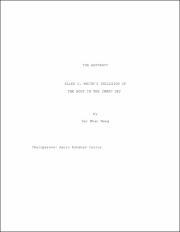Ellen G. White's inclusion of the body in the Imago Dei
Abstract
Chapter 1 introduced the problem by mentioning a
persistent discussion on the body in the imago Dei. The
study attempted to answer two basic questions. First, to
what extent is Ellen G. White’s inclusion of the body in the
imago Dei unique? Second, to what extent does Ellen G.
White share her viewpoints with others?
Chapter 2 reviewed the theological positions for the
inclusion of the body in the imago Dei in Christian
anthropology from the Early Church to twentieth century.
Those who were influenced by Greek dualism tended to exclude
the body from the imago Dei while those who took the sola
scriptura assumption included the body in the imago Dei.
Chapter 3 described Ellen G. White’s inclusion of
the body in the imago Dei. Her monistic view of man in the
imago Dei is found to permeate the SDA Church’s views of
education, health, abolitionism, and creationism. Her
biblical support for the imago Dei are found in Gen 1:26,27;
Ps 8:5-8; John 1:14; 14:9,10; Rom 8:29; 1 Cor 10:5; 2 Cor
3:18; 2 Cor 4:3-6; Eph 4:24; Col 1:15 and Heb 1:3, all of
which describe how the imago Dei relates to the totality of
human nature. The SDA Church also endorsed her imago Dei
concept by presenting the complementarity of the body and
the mind and the character as parts of the whole and Christ
as the prototype for believers’ bodily resurrection.
Chapter 4 presented the extent of her commonalities
and differences with others in (1) traditional theology,
(2) extra-biblical texts, (3) anti-dogmatic writers,
(4) neo-orthodox writers, (5) Darwinians, (6) ecologists,
(7) feminists, (8) proposers of a body theology, and
(10) Jewish theology. These commonalities and differences
are measured by the degree of their dependence on the sola
scriptura or Greek dualism.


